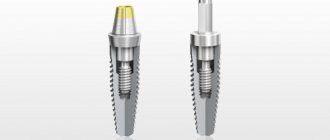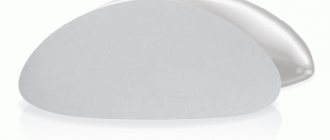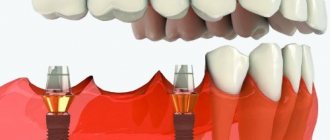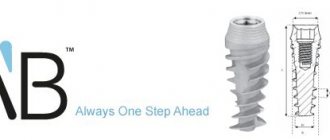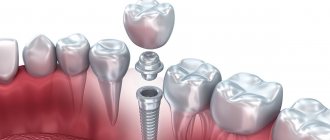What is better - a pin or an implant? This is the question asked by people who decide to restore lost teeth. To make a decision, you need to know the difference between these orthopedic structures. In some cases, a successful solution to restoring the dentition will be to implant a pin into the root of the tooth. In case of complete root removal, the replacement option is an artificial implant. Let's look at all the details in detail.
What is a pin?
The implant is a titanium rod that is screwed into the bone tissue. A crown imitating a tooth is placed on the rod. A pin, unlike an implant, is screwed into the broken tooth root. The implant completely imitates a lost tooth - from the root to the incisor. The pin is mounted into the natural tooth root.
In what cases is it recommended to install a pin into the root of a tooth? The main condition for this operation is the strength of the root itself. Before implantation, the doctor takes an x-ray to determine the extent of carious root destruction. There are cases when a broken tooth has a completely softened root base, and the introduction of a pin is not possible.
Next, the root of the tooth under the pin must be completely processed - all root canals are sealed. This cannot always be done due to the abnormal structure of the teeth. Sometimes the number of canals, tortuosity, direction and location do not allow for qualitative depulpation of the root. Another problem is the old filling. If the canal was previously sealed, it must be unsealed. Another obstacle to the installation of a pin are granulomas and cysts: they cannot be completely treated, and the source of infection remains.
And the main disadvantage of installing a pin is the fragility of the natural material. The sealed tooth is weakened and susceptible to decay. Therefore, installing a pin does not guarantee the eternity of the tooth. There are other factors that influence the rate of destruction: it is impossible to foresee everything.
However, despite all the disadvantages, preserving the roots of the teeth is a better option than extraction. The periodontal tissue performs its functions in the general functioning of the digestive system and is a connecting link in the act of chewing. Pressure on the receptors regulates the strength of the masticatory muscles, and therefore determines their demand in the body. The cessation of pressure will provoke atrophy of the masticatory muscles, which will cause dysfunction of the upper body. This may be expressed in:
- the appearance of migraines;
- pain in the cervical spine;
- shoulder pain.
Therefore, complete tooth extraction is not a solution to the problem. Partial restoration of functions using a pin structure is more physiological and beneficial for health than root removal. A few visits to the dentist and the investment of time will pay off handsomely. The root should be removed only in extreme cases.
Material of manufacture
A variety of materials can be used, including:
- Metals and composites are the most popular option, they are easy to manufacture, durable and have an affordable price;
- Ceramic - similar to natural tooth enamel, the most aesthetic option;
- Zirconium - combines the best qualities of the previous options - they are aesthetically pleasing and durable, but are not very popular because they are very expensive.
Dental implants
Now let's consider the issue of installing implants instead of a tooth. You know the difference between a pin and an implant. Modern technologies make it possible to install high-quality dental implants that completely imitate lost teeth. Installing an implant also has its own indications/contraindications. Contraindications include:
- autoimmune diseases;
- diseases of the endocrine system;
- severe cardiovascular diseases;
- oncology.
Also contraindications to implant installation are the structural features of the jaw:
- quality of bone tissue;
- sufficient height/width.
Sometimes an implant surgeon may encounter obstacles to performing an operation: insufficient bone mass. Therefore, do not be surprised if you are offered the use of donor bone tissue or its synthetic substitutes.
How is the implant installed? The operation is carried out in stages. At the first stage, the implant is implanted into the bone tissue and the body adapts to the new element. This period can last about six months. The new material must take root in the bone and integrate into the bone tissue.
The second stage involves the creation and placement of a crown on the integrated root. This stage lasts no more than two weeks. The installation of the crown is carried out after complete integration of the metal into the bone tissue.
How do you know if a titanium implant will take root? According to statistics, implanted elements take root in 95% of cases out of a hundred. This high figure is possible thanks to the latest developments. What do they do with unrooted rods? They are removed, then a new implantation of the rods is performed. Doctors guarantee a good result, however, the structure and reaction of the body may vary among patients. Some people tolerate implantation easily, while others experience complications.
How long does an implant last in the jaw? This depends on several features:
- correct installation;
- compliance with integration deadlines;
- compliance with the rules of prosthetics.
If all conditions are met, artificial teeth cannot be replaced and do not cause problems.
Differences
The pin and the implant have a common purpose - to hold the crown. In this regard, the designs are interchangeable. However, they are not complementary - a pin is not inserted into the inlay, and implantation of the implant into the pin is technically impossible.
Otherwise, these components differ significantly from each other:
- A pin is a restoration element; it serves to restore a partially lost tooth. An implant is a denture that completely replaces a lost unit.
- A pin may be placed to hold the filling in place. The implant design is not used to support a filling, as it involves the removal of the root.
- The most popular are fiberglass rods; metal pins made of titanium and steel are less commonly used. Implants are most often made of titanium and zirconium.
Types of implants
What dentures are best to install on teeth? Modern orthopedics offers the following types of implants:
- lamellar;
- root-shaped;
- combined;
- endosseous;
- subperiosteal;
- intramucosal;
- endodontically stabilized.
Plate structures are used for bone deficiency. Root-shaped structures are the most popular. They are installed when there is sufficient bone mass (own or grafted). The construction material and shape depend on the manufacturer.
The combined form is a synthesis of lamellar and root-shaped structures. Endosseous implants are implanted intraosseously, subperiosteal implants are implanted in the subperiosteal area. Intramucosal - installed without implantation into the bone mass, endodontically stabilized - through the root apex.
According to their design features, implants are divided into:
- collapsible;
- non-separable.
Collapsible implants are a structure consisting of a rod and a head. The installation process consists of two stages: implanting the rod and covering the head with a crown. This design is most popular in orthopedics: the integration of the rod into the bone tissue can be monitored.
The non-collapsible design is used in simple cases; it is less popular. However, the advantage is the speed of the prosthesis installation process and the low price of the implant.
What is the price difference
Having different dental tasks and methods of application, the installation of a pin and the implantation of an implant differ significantly in price . It is quite natural that an implant, which is a full-fledged prosthesis, is more expensive than a pin, which serves as a reinforcement of natural material.
Implantation is more durable and aesthetically pleasing, which affects its price.
| Service | Cost, rub. |
| Implantation without implant cost | 10000-20000 |
| Pin installation | 2000-5000 |
The cost of implantation in Moscow depends on the region and the prestige of the clinic. The cost of installing a pin is also affected by the material from which it is made.
Manufacturing companies
Which manufacturing companies offer the best products? All prostheses can be divided into three categories depending on the price range:
- premium;
- mid-price;
- low priced.
What is the difference between these types? The difference between these implants is durability and wear resistance. The higher the price, the stronger the structure. The high-price segment includes products from the following companies:
- Nobel Biocare;
- Straumann;
- Astra Tech.
Nobel Biocare products are characterized by a high degree of integration of the material into bone tissue. The rejection rate is almost zero. The approximate price for one tooth ranges from 40,000 to 70,000 rubles.
The Swiss company Straumann gives an unlimited warranty on its products. The price for one implant is about 45,000 rubles. The Swedish company Astra Tech estimates its products at around 35,000 per implant.
The average price category of prostheses is less durable in use. Products in this category are represented by the following companies:
- Dentsply Friadent;
- Zimmer;
- Schlutz Dental;
- Rusimplant;
- MIS.
A distinctive feature of Dentsply Friadent products is the invisibility of the transition boundary between the crown and the rod. The price for one prosthesis is 35,000 rubles. The cost of products from the American company Zimmer ranges from 18,000 to 30,000 rubles. The price depends on the size of the implant.
The German company Schlutz Dental produces a variety of products at prices ranging from 20,000 to 30,000 rubles per implant. In the same price range are products from the Russian company Rusimplant and the Israeli company MIS.
In the low price range (7,000 - 17,000 rubles) there are products from Ukrainian, Belarusian and Russian manufacturers.
Advantages and disadvantages
Such designs have a number of positive and negative qualities that you should definitely know about before you think about installing them.
Among the advantages:
- product reliability;
- aesthetic appearance;
- durable and reliable structures;
- long service life due to the fact that the crown and the securing rod are a single whole;
- uniform distribution of load volume throughout the tooth.
Among the disadvantages:
- complex and lengthy implantation procedure;
- high cost of the operation;
- a large list of contraindications,
- required volume of bone tissue.
What to choose: pin or implant?
How do imported structures differ from domestic ones, besides price? The main difference is the quality of the material and functionality of imported orthodontic structures. This is due to the great capabilities of Western companies in conducting scientific research and testing.
For example, in the manufacture of a domestic pin, laser processing of the material is not used, and when implanting this structure into the gum, surgical intervention is required. The patient must endure gum cutting, suturing, and re-cutting during the denture placement process. If a domestic implant is produced using modern technologies, then its price inevitably increases.
The advantage of imported products is as follows:
- The surface of the material is treated appropriately and integrates well into the bone tissue.
- No evidence of implant rejection was observed.
- The installation process is carried out in one visit to the doctor, does not cause pain and does not require anesthesia.
- The shape of the implant is adapted to the shape of the skull, and the load on the gums is distributed evenly.
- Aesthetically, imported prostheses look better than domestic ones, are not noticeable and do not attract attention.
- The installed implants are highly wear-resistant and do not require replacement.
The choice is obvious in favor of imported products. The Swiss company Nobel Biocare is considered the leader in dentures.
Content
- Details about the pin
- Details about the tab
- Materials for production
- What the inlay and pin have in common
- Differences
- What to choose - pin or tab
Currently, dentists offer many options for prosthetics and dental treatment. Modern technologies can solve almost any problem. It is important to choose the best option for a particular case. If treatment of a decayed tooth is required, the choice is between an inlay and a pin.
PROMOTION
Dental restoration, installation of fillings
from 2200 rub.
Complications
Can there be complications after surgery on the jaw bone tissue? The probability of complications is 5% of the total number of prosthetics. Possible complications may be as follows:
- deformation of the facial artery;
- deformation of the soft tissues of the jaw;
- deformation of the maxillary sinus;
- perforation of the nasal cavity;
- damage to nerve endings;
- bone tissue atrophy;
- implant rejection;
- foci of inflammation at the site of implantation;
- destruction and deformation of bone tissue;
- the appearance of bone growths.
However, these complications can be cured if you consult a dentist in a timely manner. An important factor in the success of implantation of dentures is the qualifications and experience of the orthodontist.
Bottom line
The process of replacing a lost tooth with an implant must be determined by the orthodontist. A person cannot decide on his own what exactly is suitable in his situation - a pin or an implant. The patient can make a choice between products from different companies, depending on their financial capabilities.
The doctor examines the patient's jaw:
- bone mass;
- bone health;
- degree of tooth decay;
- number of teeth to be replaced.
If the patient's jaw is healthy, root-shaped implants can be installed to replace the missing teeth. Of course, the decision to install this type of structure will be made by the patient - these are expensive implants.
It is cheaper to install plate-type prostheses. It is used in cases of replacing several adjacent teeth, when the bone mass is thinning, and when restoring the front row. The procedure costs less.
If there is insufficient bone mass and the patient refuses to increase it, subperiosteal prostheses are installed. Such designs are less durable, however, they have a low price category.
A damaged tooth with a strong root can be restored by introducing an endodontic stabilized implant, implanted directly into the root itself. This procedure does not disrupt bone mass and is considered the most optimal.
In exceptional cases, the implantation of combined prostheses designed individually for the patient is prescribed. If the orthodontist offers a specific option for restoring the dentition, you should listen to the specialist’s opinion.
Sources used:
- Polupan P.V. One-stage implantation – a new horizon in implantology
- Greenstein G, Cavallaro J, Romanos G, Tarnow D (Aug 2008). “Clinical recommendations for avoiding and managing surgical complications associated with implant dentistry: a review.”
- Susan Wingrove. "Focus on implant home care Before, during, and after restoration." RDH Magazine.
Crowns for ground teeth
This type of crown is different in that your own ground tooth acts as the basis for the crown. If a patient is completely missing a tooth, then to replace it with a regular crown, it is necessary to grind down the adjacent teeth and install a dental bridge on them. The load is distributed to adjacent teeth, and the resulting gap is filled with a crown. Fixed with cement. To install this type of orthopedic structure, you must have the following indications:
- The tooth is destroyed by more than 50-70%;
- The tooth has changed color and requires aesthetic restoration;
- Pathological abrasion of the enamel is observed;
- Fracture of the coronal part, chips, cracks.
Contraindications:
- Tooth mobility;
- Allergy to construction materials;
- The part of the tooth that rises above the gum has insufficient volume to fix the crown;
- Gum diseases;
- Malocclusion.
To restore chewing teeth, more practical and reliable crown options are used - metal, metal-ceramic, all-ceramic, zirconium. For front teeth, the requirements for aesthetics are higher, so ceramics, zirconium, and all-ceramic crowns are more often chosen. The service life of crowns fixed to natural teeth is about 5 years. Afterwards they are replaced with new ones, the teeth are ground down to strengthen the base. If a patient chooses between a regular crown and a crown on an implant after tooth and root removal, the implant allows you to save adjacent healthy teeth from grinding. They will last longer, the crown itself will last about 8-12 years without replacement, and with good care - 15 years. If several adjacent teeth are missing, then the likelihood of loosening and loss of teeth that serve as support increases sharply. Having chronic gum disease increases the risk of these teeth falling out.

